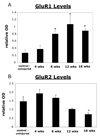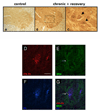Glutamate receptor plasticity and activity-regulated cytoskeletal associated protein regulation in the phrenic motor nucleus may mediate spontaneous recovery of the hemidiaphragm following chronic cervical spinal cord injury
- PMID: 18534577
- PMCID: PMC2590873
- DOI: 10.1016/j.expneurol.2008.04.017
Glutamate receptor plasticity and activity-regulated cytoskeletal associated protein regulation in the phrenic motor nucleus may mediate spontaneous recovery of the hemidiaphragm following chronic cervical spinal cord injury
Abstract
High cervical spinal cord hemisection results in paralysis of the ipsilateral hemidiaphragm; however, functional recovery of the paralyzed hemidiaphragm can occur spontaneously. The mechanisms mediating this recovery are unknown. In chronic, experimental contusive spinal cord injury, an upregulation of the NMDA receptor 2A subunit and a downregulation of the AMPA receptor GluR2 subunit have been correlated with improved hind limb motor recovery. Therefore, we hypothesized that NR2A is upregulated, whereas GluR2 is down-regulated following chronic C2 hemisection to initiate synaptic strengthening in respiratory motor pathways. Since NMDA receptor activation can lead to the delivery of AMPA receptor subunits to the post-synaptic membrane, we also hypothesized that there would be an upregulation of the GluR1 AMPA receptor subunit and that activity-regulated cytoskeletal associated protein may mediate the post-synaptic membrane delivery. Female rats were hemisected at C2 and allowed to recover for different time points following hemisection. At these time points, protein levels of NR2A, GluR1, and GluR2 subunits were assessed via Western blot analysis. Western blot analysis revealed that there were increases in NR2A subunit at six and twelve weeks post C2 hemisection. At six, twelve, and sixteen weeks post hemisection, the GluR1 subunit was increased over controls, whereas the GluR2 subunit decreased sixteen weeks post hemisection. Immunocytochemical data qualitatively supported these findings. Results also indicated that activity-regulated cytoskeletal associated protein may be associated with the above changes. These findings suggest a role of NR2A, GluR1, and GluR2 in mediating chronic spontaneous functional recovery of the paralyzed hemidiaphragm following cervical spinal cord hemisection.
Figures








References
-
- Alsbo CW, Wrang ML, Moller F, Diemer NH. Is the AMPA receptor subunit GluR2 mRNA an early indicator of cell fate after ischemia? A quantitative single cell RT-PCR study. Brain Res. 2001;894:101–108. - PubMed
-
- Asztely F, Erdemli G, Kullmann DM. Extrasynaptic glutamate spillover in the hippocampus: dependence on temperature and the role of active glutamate uptake. Neuron. 1997;18:281–293. - PubMed
-
- Barbour B, Hausser M. Intersynaptic diffusion of neurotransmitter. Trends Neurosci. 1997;20:377–384. - PubMed
-
- Bennett MV, Pellegrini-Giampietro DE, Gorter JA, Aronica E, Connor JA, Zukin RS. The GluR2 hypothesis: Ca(++)-permeable AMPA receptors in delayed neurodegeneration. Cold Spring Harb Symp Quant Biol. 1996;61:373–384. - PubMed
Publication types
MeSH terms
Substances
Grants and funding
LinkOut - more resources
Full Text Sources
Medical
Miscellaneous

